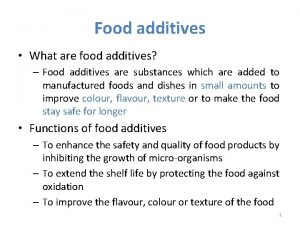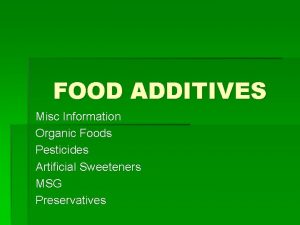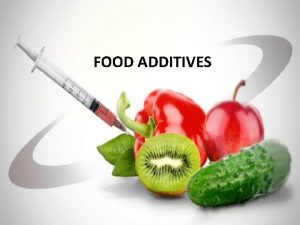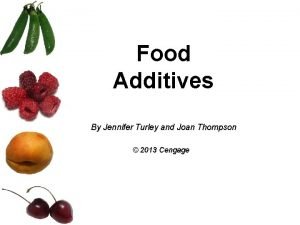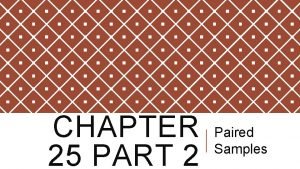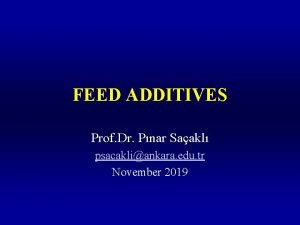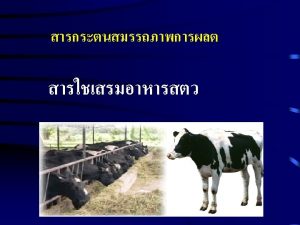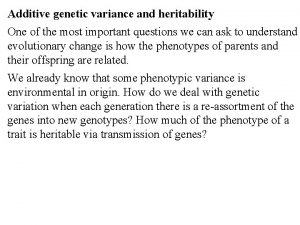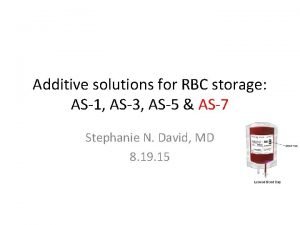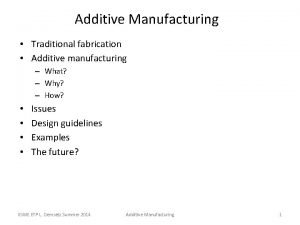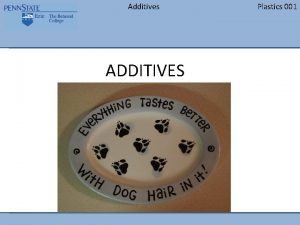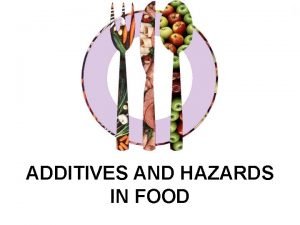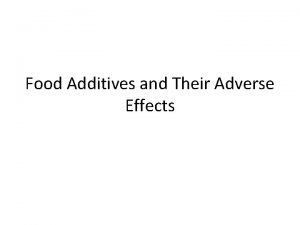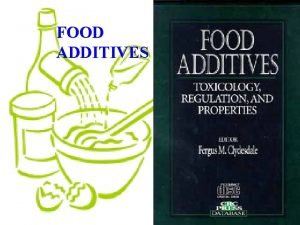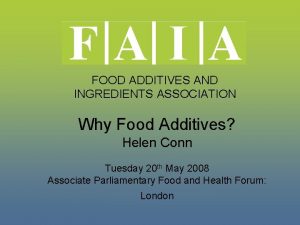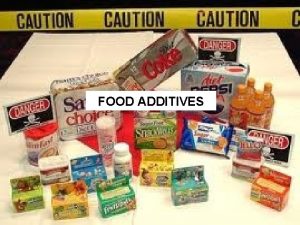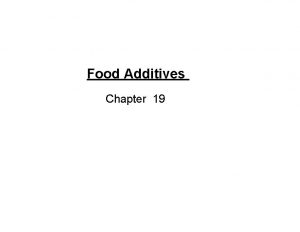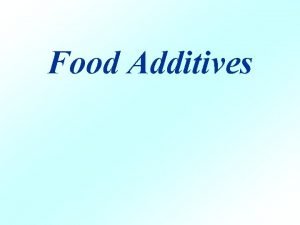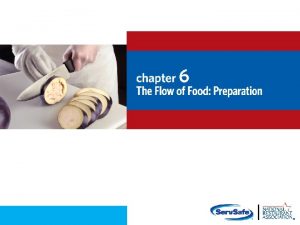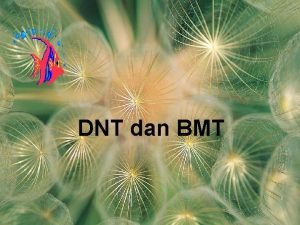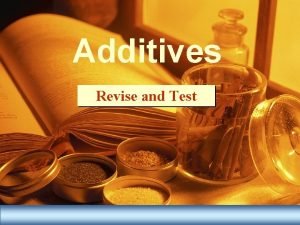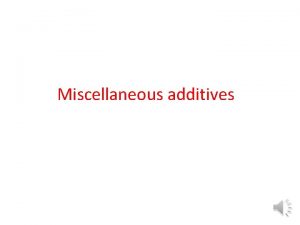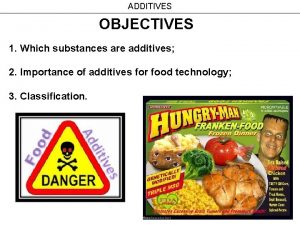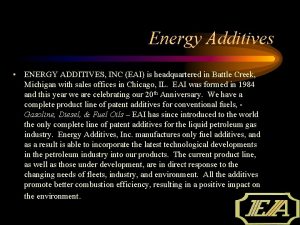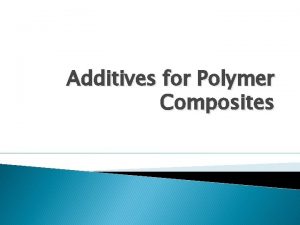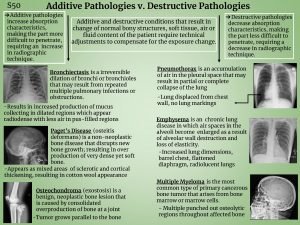Food Additives 1 A food additive is a























- Slides: 23

Food Additives 1

“A food additive is a substance or mixture of substances, other than the basic food stuff, which is present in food as a result of any aspect of production, processing, storage or packaging. The term does not include chance contamination” (WHO, 1965). 2

Those food additives which are specifically added to prevent the deterioration or decomposition of a food have been referred to as chemical preservatives. The inhibition of the growth and activity of microorganisms is one of the main purposes of the use of chemical preservatives. 3

Preservatives may inhibit microorganisms by: interfering with their enzyme activity, or interfering with their genetic mechanisms interfering with their cell membranes, 4

THE IDEAL ANTIMICROBIAL PRESERVATIVE 1. A chemical preservative should have a wide range of antimicrobial activity; 2. Should be non toxic to human beings or animals; 3. Should be economical; 4. Should not have an effect on the flavor, taste, or aroma of the original food; 5. Should not be inactivated by the food or any substance in the food; 6. Should not encourage the development of resistant strains; and 7. Should kill rather than inhibit microorganisms. 5

ADDED PRESERVATIVES The Federal Food, Drug, and Cosmetic Act, as amended by the Food Additives Amendment of 1958, defines a chemical preservative as “any chemical which, when added to food, tends to prevent or retard deterioration thereof; but does not include common salt, sugars, vinegars, spices, or oils extracted from spices, or substances added by. . woodsmoke. ” 6

Antimicrobial preservatives added to foods can be grouped as follows: 1 Those added preservatives not defined as such by law: natural organic acids (lactic, malic, citric, etc. ) and their salts, vinegars (acetic is a natural acid), sodium chloride, sugars, spices and their oils, woodsmoke, carbon dioxide, and nitrogen. 2 Substances generally recognized as safe (GRAS) for addition to foods: propionic acid and sodium and calcium propionates, caprylic acid, sorbic acid and potassium, sodium, and calcium sorbates, benzoic acid and benzoates and derivatives of benzoic acid such as methylparaben and propylparaben, sodium diacetate, sulfur dioxide and suffites, potassium and sodium bisulfite and metabisulfite, and sodium nitrite. 7

3 Chemicals considered to be food additives, which would include all not listed in the first two categories. They can be used only when proved safe for humans or animals, and they then fall into group 4. 4 Chemicals proved safe and approved by the Food and Drug Administration. 8

Organic Acids and Their Salts Lactic, acetic, propionic, and citric acids or their salts may be added to or developed in foods. Citric acid is used in sirups, drinks, jams, and jellies as a substitute for fruit flavors and for preservation. Lactic and acetic acids are added to brines of various kinds, green olives, etc. 9

Propionates Sodium or calcium propionate is used most extensively in the prevention of mold growth and rope development in baked goods and for mold inhibition in many cheese foods and spreads. They are effective against molds, with little or no inhibition of most yeast and bacteria. Their effectiveness decreases with an increase in p. H, with an optimal upper limit of about p. H 5 to 6, depending on the food item. They appear to be ideal preservatives for bread and baked goods. 10

Propionic acid is a short-chain fatty acid (CH 3 CH 2 COOH) and, like some other fatty acids, perhaps affects the cell-membrane permeability. Propionic acid is found naturally in Swiss cheese, as a developed preservative, at levels up to 1 percent. Benzoates The sodium salt of benzoic acid has been used extensively as an antimicrobial agent in foods. It has been incorporated into jams, jellies, margarine, carbonated beverages, fruit salads, pickles, relishes, fruit juices, etc. 11

Sorbates Sorbic acid, as the calcium, sodium, or potassium salt, is used as a direct antimicrobial additive in foods and as a spray, dip, or coating on packaging materials. It is widely used in cheeses, cheese products, baked goods, beverages, situps, fruit juices, jellies, jams, fruit cocktails, dried fruits, pickles, and margarine. Sorbic acid and its salts are known to inhibit yeast and molds but are less a effective against bacteria. 12

Dehydroacetic acid has been used to impregnate wrappers for cheese to inhibit the growth of molds and as a temporary preservative for squash. Acetic acid in the form of vinegar is used in mayonnaise pickles, catsup, pickled sausages, and pigs’ feet. Acetic acid is more effective against yeasts and bacteria than against molds, and its effectiveness increases with a decrease in p. H, which would favor the presence of the undissociated acid. 13

Nitrites and Nitrates Combinations of these various salts have been used in curing solutions and curing mixtures for meats. Nitrites decompose to nitric acid, which forms nitrosomyoglobin when it reacts with the heme pigments in meats and thereby forms a stable red color. Nitrates probably only act as a reservoir for nitrite, and their use is being restricted. Nitrites can react with secondary and tertiary amines to form nitrosamines, which are known to be carcinogenic. 14

Preservative Concentration allowed 0. 1%, covered by good manufacturing Benzoic acid practices (GMPs) Methylparaben 0. 1%, covered by GMPs Propylparaben 0. 1%, covered by GMPs Ethylparaben Not authorized for use Sodium nitrate 500 ppm Sodium nitrite 200 ppm Sorbates Covered by GMPs Acetates (acetic Covered by GMPs with concentrations acid) from 0. 25 to 9. 0% 300 ppm cocoa, gums, starch, spices, Propylene oxide processed nutmeats (except peanuts) Ethylene oxide Residues not to exceed 50 ppm Sulfites Covered by GMPs 200 to 300 ppm as a dip, spray, or Natamycin solution 15

Sulfur dioxide and sulfites are used in the wine industry to sanitize equipment and to reduce the normal flora of the grape must. In aqueous solutions, sulfur dioxide and various sulfites, including sodium sulfite, potassium sulfite, sodium bisulfite, potassium bisuifite, sodium metabisulfite, and potassium metabisulfite, form sulfurous acid, the active antimicrobial compound. Sulfur dioxide has also been used in sirups and fruit juices and, of course, wine making. Some countries permit the use of sulfites on meats and fish. In addition to the antimicrobial action of sulfites, they are also used to prevent enzymatic and nonenzymatic changes or discoloration in some foods. 16

Ethylene and Propylene Oxide Ethylene oxide kills all microorganisms; propylene oxide, although it kills many microorganisms, is not as effective. They are thought to act as strong alkylating agents attacking labile hydrogens. The primary uses have been as sterilants for packaging materials, fumigation of warehouses, and “cold sterilization” of numerous plastics, chemicals, pharmaceuticals, syringes, and hospital supplies. 17

Sugar and Salt Theses compounds lower the a and thus have an adverse effect on microorganisms. Sodium chloride is used in brines and curing solutions or is applied directly to the food 18

Salt has been reported to have the following effects: (1) It causes high osmotic pressure and hence plasmolysis of cells, the percentage of salt necessary to inhibit growth or harm the cell varying with the microorganism, (2) it dehydrates foods by drawing out and tying up moisture as it dehydrates microbial cells, (3) it ionizes to yield the chlorine ion, which is harmful to organisms, (4) it reduces the solubility of oxygen in the moisture, (5) it sensitizes the cell against carbon dioxide, and 19

Alcohol Ethanol, a coagulant and denaturize of cell proteins, is most germicidal in concentrations between 70 and 95 percent. Flavoring extracts, e. g. , vanilla and lemon extracts, are preserved by their content of alcohol. The alcoholic content of beer, ale, and unfortified wine is not great enough to prevent their spoilage by microorganisms but limits the types able to grow. Liqueurs and distilled liquors usually contain enough alcohol to ensure freedom from microbial attack. 20

Formaldehyde The addition of formaldehyde to foods is not permitted, except as a minor constituent of woodsmoke, but this compound is effective against molds, bacteria, and viruses and can be used where its poisonous nature and irritating properties are not objectionable. Thus it is useful in the treatment of walls, shelves, successfully in dried fruits, dried eggs, gelatin, cereals, dried yeast, and spices. 21

Antibiotics Most of the better-known antibiotics have been tested on raw foods, chiefly proteinaceous ones like meats, fish, and poultry, in an endeavor to lengthen the storage time at chilling temperatures. Aureomycin has been found superior to other antibiotics tested because of its broad spectrum of activity. Terramycin (oxytetracycline) is almost as good for lengthening the time of preservation of foods. It has been recommended that antibiotics selected for use in food preservation be other than those being used in the treatment of human diseases. 22

DEVELOPED PRESERVATIVES The preservatives produced in foods by microbial action are for the most part acids (chiefly lactic) and alcohol. The preservative effect of these substances nearly always is supplemented by one or more additional preservative agents, such as low temperature, heat, anaerobic conditions, sodium chloride, sugar, or added acid. Developed acidity plays a part in the preservation of sauerkraut, pickles, green olives, fermented milk, cheese, and certain sausages and in various fermented foods of plant origin. The alcohol content of beer, ale, fermented fruit juices, and distilled liquors has a preservative effect but was not produced primarily for that purpose. 23
 Acetic acid examples
Acetic acid examples Advantages and disadvantages of food additives
Advantages and disadvantages of food additives Msg pesticide
Msg pesticide Substance added to food
Substance added to food Examples of intentional food additives
Examples of intentional food additives Natural and artificial food additives
Natural and artificial food additives Having done poorly on their math
Having done poorly on their math The monophasic liquid are prepared with aqueous solution
The monophasic liquid are prepared with aqueous solution High performance additives
High performance additives Example of plasticizer
Example of plasticizer Colors of regulation
Colors of regulation Incidental additives examples
Incidental additives examples Saakl
Saakl Quadratic color scheme
Quadratic color scheme Feed additive dan feed supplement
Feed additive dan feed supplement Additive genetic variation definition
Additive genetic variation definition Additive thinking
Additive thinking Additive colour theory of light
Additive colour theory of light Additive identity property example
Additive identity property example Nonlinear multiple regression
Nonlinear multiple regression As-1 additive solution
As-1 additive solution Coreless製程
Coreless製程 What is multiplicative inverse
What is multiplicative inverse Additive manufacturing
Additive manufacturing
